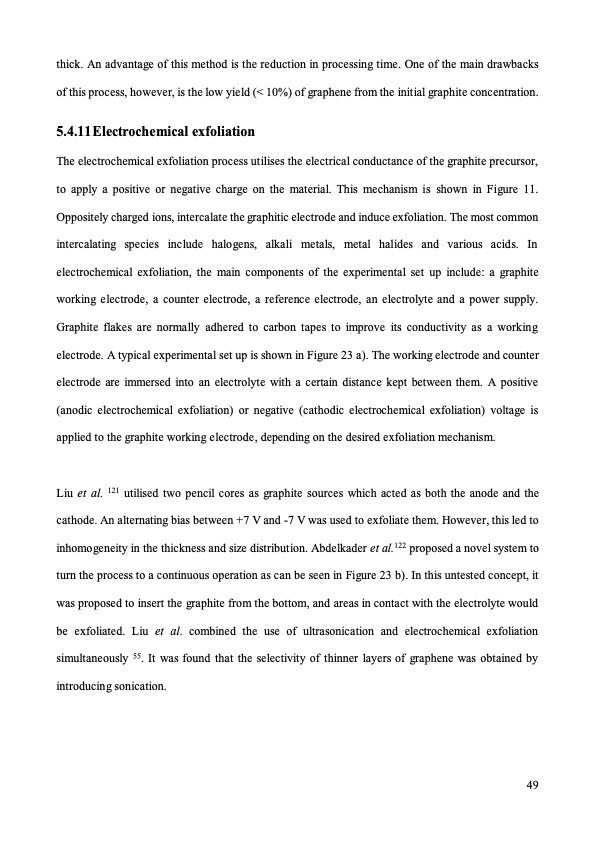PDF Publication Title:
Text from PDF Page: 049
thick. An advantage of this method is the reduction in processing time. One of the main drawbacks of this process, however, is the low yield (< 10%) of graphene from the initial graphite concentration. 5.4.11Electrochemical exfoliation The electrochemical exfoliation process utilises the electrical conductance of the graphite precursor, to apply a positive or negative charge on the material. This mechanism is shown in Figure 11. Oppositely charged ions, intercalate the graphitic electrode and induce exfoliation. The most common intercalating species inc lude halo gens, alkali metals, metal halides and various acid s. In electrochemical exfoliation, the main components of the experimental set up include: a graphite working electrode, a counter electrode, a reference electrode, an electrolyte and a power supply. Graphite flakes are normally adhered to carbon tapes to improve its conductivity as a working electrode. A typical experimental set up is shown in Figure 23 a). The working electrode and counter electrode are immersed into an electrolyte with a certain distance kept between them. A positive (anodic electrochemical exfoliation) or negative (cathodic electrochemical exfoliation) voltage is applied to the graphite working electrode, depending on the desired exfoliation mechanism. Liu et al. 121 utilised two pencil cores as graphite sources which acted as both the anode and the cathode. An alternating bias between +7 V and -7 V was used to exfoliate them. However, this led to inhomogeneity in the thickness and size distribution. Abdelkader et al.122 proposed a novel system to turn the process to a continuous operation as can be seen in Figure 23 b). In this untested concept, it was proposed to insert the graphite from the bottom, and areas in contact with the electrolyte would be exfoliated. Liu et al. combined the use of ultrasonication and electrochemical exfoliation simultaneously 55. It was found that the selectivity of thinner layers of graphene was obtained by introducing sonication. 49PDF Image | graphene production via nonoxidizing liquid exfoliation

PDF Search Title:
graphene production via nonoxidizing liquid exfoliationOriginal File Name Searched:
Graphene-R2-review.pdfDIY PDF Search: Google It | Yahoo | Bing
Salgenx Redox Flow Battery Technology: Power up your energy storage game with Salgenx Salt Water Battery. With its advanced technology, the flow battery provides reliable, scalable, and sustainable energy storage for utility-scale projects. Upgrade to a Salgenx flow battery today and take control of your energy future.
CONTACT TEL: 608-238-6001 Email: greg@infinityturbine.com (Standard Web Page)